Untergriesbach
| Untergriesbach | ||
|---|---|---|
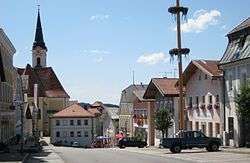 | ||
| ||
 Untergriesbach | ||
Location of Untergriesbach within Passau district 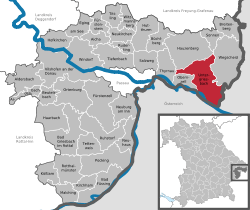 | ||
| Coordinates: 48°34′30″N 13°40′5″E / 48.57500°N 13.66806°ECoordinates: 48°34′30″N 13°40′5″E / 48.57500°N 13.66806°E | ||
| Country | Germany | |
| State | Bavaria | |
| Admin. region | Niederbayern | |
| District | Passau | |
| Government | ||
| • Mayor | Hermann Duschl (CWG) | |
| Area | ||
| • Total | 73.60 km2 (28.42 sq mi) | |
| Population (2015-12-31)[1] | ||
| • Total | 6,004 | |
| • Density | 82/km2 (210/sq mi) | |
| Time zone | CET/CEST (UTC+1/+2) | |
| Postal codes | 94107 | |
| Dialling codes | 08593 | |
| Vehicle registration | PA | |
| Website |
www | |
Untergriesbach (Central Bavarian: Untagriasbo) is a municipality in the district of Passau in Bavaria in Germany.
Geography
Untergriesbach is located in the southern Bavarian Forest and extends high above the deep valley of the Danube. The height of the market town is 565 meters above sea level. Via the Bundesstraße 388 it is connected to Passau (22 km) and in the opposite direction to the Upper Austrian Haslach (32 km).

History
The name comes from the nobles of Griesbach. These were a rich noble family with numerous possessions in the "land of the Abbey" (Passauer Abbey Country). Nothing remains from the former castle.
Originally it was named "Griespach", then "Griesbach on high market" (to distinguish it from "Griesbach in the cell" = Obernzell) and finally renamed in 1806 to Untergriesbach (to distinguish it from Bad Griesbach in the Rott Valley).
The nobles of Griesbach died out in the early 13th century. Their successors were the Wessenberger who possessed an extended property as a fief of the Bishopric Passau. The castle was probably destroyed after the death of the last Wessenberger around 1240.
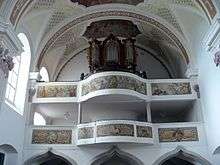
1260 Bishop Otto of Lonsdorf (approx. 1200-1265) gave the rights to hold a market and other privileges. During the Passau citizens revolt against Bishop Albert III. von Winkel (died 1380) Untergriesbach was burned down 1367 by insurgents from Passau. In 1456 Bishop Ulrich of Nussdorf confirmed and extended the rights and freedoms of the market.
Untergriesbach was largely spared from Thirty Years' War, but the Bavarian and Imperial troops, who were billeted here, imported in 1648 the plague during the last year of the war, which raged until early 1650 with great violence.
The late Gothic parish church of St. Michael was remodeled baroque in several stages during the 18th century. In 1803 the market Griesbach came to Ferdinand III, Grand Duke of Tuscany (1769-1824) and 1806 to Kingdom of Bavaria. The trader Georg Saxinger was elected the first mayor. 1829 a new school building was erected, from 1829 to 1830 was built a new road to Obernzell, which was much more comfortable to drive than the old mountain road.
In 1903 the name of the municipality Griesbach was officially changed to Untergriesbach.[2] 1956 was built in the area of the municipality the water power plant Jochenstein.
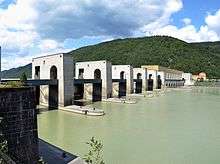
Municipality arrangement
Untergriesbach has 106 districts:[3]
- Bachhäusl
- Berghof
- Brunnreut
- Dienberg
- Diendorf
- Dürrmühle
- Eck
- Eckersäg
- Eckerstampf
- Eckmühle
- Endsfelden
- Feldhäuslhäusl
- Ficht
- Fichtwiesen
- Friedlgrub
- Gammertshof
- Gebrechtshof
- Gebrechtsmühle
- Glotzing
- Gotting
- Gottsdorf
- Grögöd
- Grub
- Grunau
- Habersdorf
- Hamet
- Hanzing
- Hastorf
- Haunersdorf
- Herrenwies
- Hinterkühberg
- Hintersäg
- Hitzing
- Hochreut
- Hochwiesl
- Höhenberg
- Holzhäusl
- Hubing
- Hundsruck
- Jochenstein
- Kagerreut
- Kappelgarten
- Kinzesberg
- Knapphäusl
- Knittlmühle
- Kohlbachmühle
- Kroding
- Kronawitten
- Kronawitthof
- Krottenthal
- Kühberg
- Lämersdorf
- Leizesberg
- Linden
- Lindlmühle
- Mairau
- Mittereck
- Mitterreut
- Nebling
- Neureuth
- Niederdorf
- Oberöd
- Oberötzdorf
- Oberreut
- Ochsenreut
- Ornatsöd
- Paulusberg
- Pfaffenreut
- Priel
- Ramesberg
- Rampersdorf
- Ratzing
- Rechab
- Reut
- Richtermühle
- Riedl
- Riedlerhof
- Roll
- Rothkreuz
- Saxing
- Schaibing
- Schergendorf
- Scherleinsöd
- Schreinerhäusl
- Spechting
- Sperrhäusl
- Steinbruck
- Steinbüchl
- Stollberg
- Stollbergmühle
- Tabakstampf
- Taubing
- Untergriesbach
- Unteröd
- Unterötzdorf
- Unterreut
- Vorholz
- Waldfriede
- Weidwies
- Wesseslinden
- Willersdorf
- Würm
- Würmmühle
- Zaunbrechl
- Ziering
- Zipf
Incorporations
On 1 October 1971, the previously independent municipality Lambsdorf was incorporated. On 1 January 1972 Gottsdorf and Schaibing were added. Oberötzdorf followed on 1 March 1972.[2]
Transportation
A railway terminal was built in 1904 in Schaibing, located at the Passau-Hauzenberg railway. On this route the passenger transport ended in 1970, the freight transport ended in 1997. There are efforts to reactivate this route.
In 1912 Untergriesbach got connected to the Passau–Hauzenberg railway by a Rack railway. Rail traffic ceased in 1965, in 1975 the track Obernzell-Wegscheid was removed.
Town council
The town council has been elected in the local elections on 2 March 2008 as follows:
- CSU: 7 seats (36.3% of votes)
- Freie Wähler Bayern: 6 seats (27.6% of votes)
- Christian Electoral Community: 4 seats (22.4% of votes)
- SPD: 3 seats (13.7% of votes)
Crest
Blazon: "Argent, a left-facing rising red wolf."
Educational institutions
- Kindergarten
- Primary and secondary school
- Gymnasium Untergriesbach
Culture
- Twinned city is Civezzano (Trentino, Italy)
- A festival is held every 3 years in the second weekend in July in conjunction with the local history days (Heimattage).
Attractions
- St Michael, late gothic parish church, refurbished in the 18th in the baroque style
- Village chapel, built from 1765 to 1768
- Parish Church of St. Jakob (Elder) in Gottsdorf
- Pillory from 1490 as a sign of the former low jurisdiction of the market
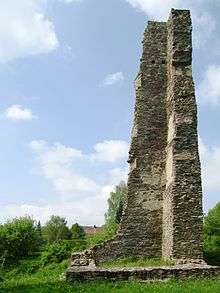
- Ruins Castle Altjochenstein and Castle Neujochenstein
People from Untergriesbach
- Christian Goller (born 1943 in Untergriesbach), German painter and art restorer
- Ottfried Fischer (born 1953 in Ornatsöd), actor and cabaretist
- Theoderich Hagn (born 23. March 1816 in Untergriesbach), Abbot of Lambach
- Friedrich Oberneder (born 25 September 1891 in Pölzöd), theologian and poet
- Rudolf Wimmer (born 10 April 1849 in Gottsdorf), painter
Sports and Teams
- The largest association of the town is the sports-club SV Untergriesbach with approximately 850 members.
- The veterans of the world wars, former and active soldiers of the Bundeswehr are organized in the soldiers and veterans associations in Untergriesbach, Schaibing and Gottsorf respectively.
References
![]() Media related to Untergriesbach at Wikimedia Commons
Media related to Untergriesbach at Wikimedia Commons
- ↑ "Fortschreibung des Bevölkerungsstandes". Bayerisches Landesamt für Statistik und Datenverarbeitung (in German). June 2016.
- 1 2 Wilhelm Volkert (Hrsg.) (1983) (in German), Handbuch der bayerischen Ämter, Gemeinden und Gerichte 1799–1980, München: C.H.Beck’sche Verlagsbuchhandlung, pp. 590, ISBN 3-406-09669-7
- ↑ Untergriesbach in Bayerische Landesbibliothek Online
